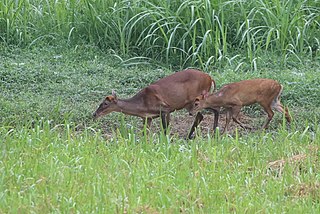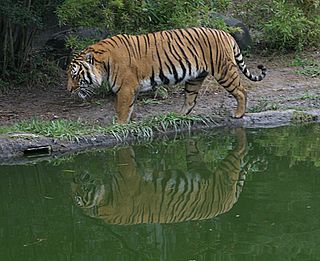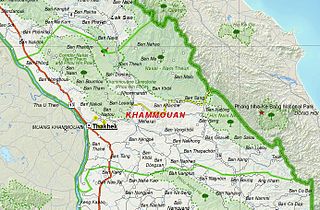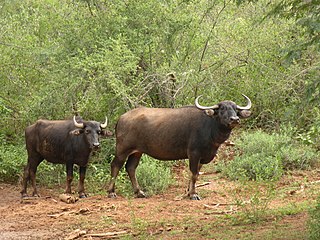
Bovines comprise a diverse group of 10 genera of medium to large-sized ungulates, including cattle, bison, African buffalo, water buffalos, and the four-horned and spiral-horned antelopes. The evolutionary relationship between the members of the group is still debated, and their classification into loose tribes rather than formal subgroups reflects this uncertainty. General characteristics include cloven hooves and usually at least one of the sexes of a species having true horns. The largest extant bovine is the gaur.

The giant muntjac, sometimes referred to as the large-antlered muntjac, is a species of muntjac deer. It is the largest muntjac species and was discovered in 1994 in Vũ Quang, Hà Tĩnh Province of Vietnam and in central Laos. During inundation of the Nakai Reservoir in Khammouane Province of Laos for the Nam Theun 2 Multi-Purpose Project, 38 giant muntjac were captured, studied, and released into the adjacent Nakai-Nam Theun National Protected Area. Subsequent radio-tracking of a sample of these animals showed the relocation was successful. The species is also located in parts of eastern Cambodia, as well as the Annamite Mountains.

The four-horned antelope, or chousingha, is a small antelope found in India and Nepal. Its four horns distinguish it from most other bovids, which have two horns. The sole member of the genus Tetracerus, the species was first described by French zoologist Henri Marie Ducrotay de Blainville in 1816. Three subspecies are recognised. The four-horned antelope stands nearly 55–64 centimetres (22–25 in) at the shoulder and weighs nearly 17–22 kilograms (37–49 lb). Slender with thin legs and a short tail, the four-horned antelope has a yellowish brown to reddish coat. One pair of horns is located between the ears, and the other on the forehead. The posterior horns are always longer than the anterior horns, which might be mere fur-covered studs. While the posterior horns measure 8–12 centimetres (3.1–4.7 in), the anterior ones are 2–5 centimetres (0.79–1.97 in) long.

The southern red muntjac is a deer species native to Southeast Asia. It was formerly known as the Indian muntjac or the common muntjac before the species was taxonomically revised to represent only populations of Sunda and perhaps Malaysia. The other populations being attributed to this species are now attributed to Muntiacus vaginalis. Muntjacs are also referred to as barking deer. It is listed as Least Concern on the IUCN Red List.

Owston's palm civet is a viverrid native to Vietnam, Laos and a very small portion of southern China, in three counties located in the Yunnan province: Hekou, Luchun, and Jinping, and has never been found west of the Mekong River. It is listed as Endangered on the IUCN Red List because of an ongoing population decline, estimated to be more than 50% over the last three generations, inferred from over-exploitation, habitat destruction and degradation.

Indo-Burma is a biodiversity hotspot designated by Conservation International.

The wildlife of Laos encompasses the animals and plants found in the Lao People's Democratic Republic, a landlocked country in southeastern Asia. Part of the country is mountainous and much of it is still clad in tropical broadleaf forest. It has a great variety of animal and plant species.
The Green Corridor project was a four-year initiative that started in June 2004, implemented by the World Wide Fund for Nature (WWF) Greater Mekong Programme and the Thừa Thiên Huế Provincial Forest Protection Department. According to the agreement signed in Huế on May 7, 2004, The Global Environment Facility, the World Wildlife Fund, and the Development Organisation of the Netherlands donated two million US dollars to protect biodiversity in Vietnam. The project also received funding from the US Fish and Wildlife Service, under the Multinational Species Conservation Fund and the Concannon Foundation, for primate surveys and conservation work, as well as the Thừa Thiên Huế Provincial People's Committee. A Green Corridor containing 1,340 square kilometres (520 sq mi) of precious forest in the districts of A Lưới, Nam Đông and Hương Thủy of Thừa Thiên Huế Province were better protected with a new method of ensuring higher efficiency.

Pù Mát National Park is a national park in Nghệ An Province, in Vietnam's North Central Coast region. It is part of the Western Nghệ An Biosphere Reserve.

The tribe Bovini or wild cattle are medium to massive bovines that are native to Eurasia, North America, and Africa. These include the enigmatic, antelope-like saola, the African and Asiatic buffalos, and a clade that consists of bison and the wild cattle of the genus Bos. Not only are they the largest members of the subfamily Bovinae, they are the largest species of their family Bovidae. The largest species is the gaur, weighing up to 1,500 kg (3,300 lb).
Nakai-Nam Theun National Park in Nakai District, Khammouane Province, Laos, is one of the last remaining wildernesses in Southeast Asia. Nakai-Nam Theun covers approximately 4,270 km2 of the Annamite Range and the adjacent Nakai Plateau in Khammouane and Bolikhamsai Provinces. It was designated a national park on 15 February 2019 by Prime Ministerial Decree No. 36, 15 February 2019. It is managed by the Ministry of Agriculture and Forestry (MAF). It is adjacent to the Vu Quang National Park of Vietnam.
Vũ Quang National Park is a national park in Vũ Quang District, Hà Tĩnh Province, North Central Coast, Vietnam. This park contains biodiversity. Saola and giant muntjac are species found in this park. Vũ Quang is a remote forested region of Vietnam, in which several new species of deer and antelope have been discovered since the 1990s. Some are so new that scientific description is still pending, although most have local names.
The Phou Hin Poun National Biodiversity Conservation Area, formerly known as the Khammouane Limestone National Biodiversity Conservation Area, is one of 21 National Biodiversity Conservation Areas of the Lao People's Democratic Republic. Located in a limestone tower karst region of the Annamite Range in Khammouane Province, it is home to a number of rare or newly discovered species. National Biodiversity Conservation Areas are not protected by the government of Laos in any meaningful way; the budget for each is about $500. The human population of the NBCA is 29,603.

The Saola Working Group (SWG) is a working group of the IUCN Species Survival Commission's Asian Wild Cattle Specialist Group, created in 2006 to protect the saolas and their habitat. The Conservancy works to engage and incorporate local communities in protecting saolas in Annamite Range mountains on the border of Laos and Vietnam. The Saola is one of the most endangered species in the world. Discovered in 1992 it was the first large mammal new to science in more than 50 years and has never been seen by a biologist in the wild. The Saola Working Group is a coalition that includes about 40 experts from the forestry departments of Laos and Vietnam, Vietnam's Institute of Ecology and Biological Resources, Vinh University, biologists and conservationists from Wildlife Conservation Society and the World Wildlife Fund.

Bolikhamsai is a province of Laos. Pakxan, Thaphabat, Pakkading, Borikhane, Viengthong, and Khamkeut are its districts and Pakxan is its capital city. The province is the site of the Nam Theun 2 Dam, the country's largest hydroelectric project.

Khammouane province (Khammouan) is a province in the center of Laos. Its capital lies at Thakhek.

Many areas of Vietnam are under protection. While the national reserves cover small areas of scientific significance with restricted access, the national parks also cover wetlands of Ramsar designated areas and BirdLife International inscribed bird areas. The largest of the national parks initially covered were the Cúc Phương National Park, the Cát Tiên National Park, and the Côn Đảo National Park which to start with were forest areas cum reserves or prohibited areas. The objective for creating national parks was to allow access to the reserved areas as a part of ecotourism and cultural needs with full attention to the basic approach of conservation of natural environmental resources.

Bubalina is a subtribe of wild cattle that includes the various species of true buffalo. Species include the African buffalo, the anoas, and the wild water buffalo. Buffaloes can be found naturally in sub-Saharan Africa, South Asia and Southeast Asia, and domestic and feral populations have been introduced to Europe, the Americas, and Australia. In addition to the living species, bubalinans have an extensive fossil record where remains have been found in much of Afro-Eurasia.

The Northern Annamites rain forests ecoregion covers the rugged and relatively unexplored northern Annamite Mountains of central Laos and Vietnam. There are high numbers of endemic plant species, and the relative remoteness and isolation of the area supports many rare and endangered animals. Rainfall is somewhat less than the lowland rainforest of the lower elevations in Vietnam, and the temperatures slightly cooler due to the higher elevation.




















